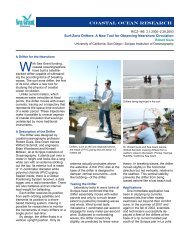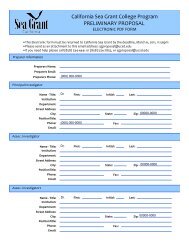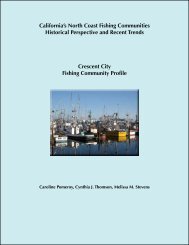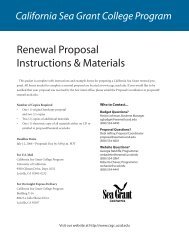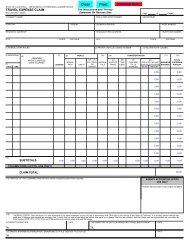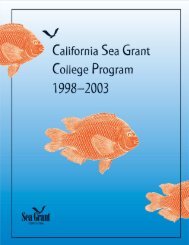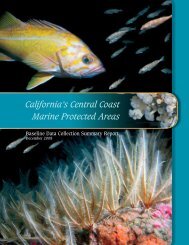2001â2002 - California Sea Grant - UC San Diego
2001â2002 - California Sea Grant - UC San Diego
2001â2002 - California Sea Grant - UC San Diego
You also want an ePaper? Increase the reach of your titles
YUMPU automatically turns print PDFs into web optimized ePapers that Google loves.
Aquatic Invader Appears Free of Dangerous Human Parasite … Future Outbreak Possible<br />
In 1992, shrimp trawlers in South<br />
<strong>San</strong> Francisco Bay hauled up the<br />
first mitten crabs on the West Coast.<br />
Since then, the crabs have spread like<br />
wildfire throughout the Bay–Delta,<br />
clogging fish screens at water intake<br />
stations and injuring fish in salvage<br />
tanks.<br />
States like Oregon and Alaska are<br />
now on high alert, worried mitten<br />
crabs will burrow into the Northwest’s<br />
economy next. So far, however,<br />
only one mitten crab has been<br />
identified outside the Bay–Delta<br />
area. In 1998, a male Japanese mitten<br />
crab, a close relative of the Chinese<br />
mitten crab, was pulled from the<br />
Columbia River in Oregon, fanning<br />
concerns of an alien invasion.<br />
The Chinese mitten crab is native to estuaries and<br />
creeks in the Yellow <strong>Sea</strong> in China and Korea.<br />
Besides its furry pinchers, which earn it its sobriquet,<br />
it is a nondescript brown crab—about 3 inches in<br />
diameter. Photo: Lee Mecum, <strong>California</strong><br />
Department of Fish and Game<br />
Although notorious for clogging pumping stations, eroding levees and stealing<br />
bait, the Chinese mitten crab poses a perhaps equally significant, albeit less<br />
recognized, human-health threat as a host for a group of parasites known as lung<br />
flukes. In this project, completed in the spring of 2002, <strong>California</strong> <strong>Sea</strong> <strong>Grant</strong> funded marine<br />
researchers to search for evidence of these potentially dangerous parasites in the <strong>San</strong> Francisco<br />
Bay–Delta. A second part of the scientists’ research looked at whether all requisite hosts<br />
for the flukes are present in sufficient abundance and distribution to sustain a future infestation.<br />
Flukes come in Asian and North American varieties and can be acquired by eating raw or<br />
undercooked infected mitten crabs (Eriocheir sinensis). People infected with flukes may<br />
develop tuberculosis-like symptoms, resulting in permanent lung damage. The parasites can<br />
also migrate into the brain. Fluke infections are very common in Asia, where fresh mitten<br />
crabs, eaten raw, are a delicacy.<br />
None of this would be such a serious concern—and wildlife officials could focus on dealing<br />
with the crabs’ ecological consequences in the area—but for the fact that these furry-clawed<br />
crustaceans are a prized culinary treat within immigrant communities in <strong>San</strong> Francisco and<br />
Los Angeles. Despite prohibitions on their transport and sale, there is a flourishing underground<br />
market in live mitten crabs. In addition, it is legal, with a fishing permit, to<br />
recreationally trap and eat mitten crabs.<br />
Because of this, health officials have expressed concern about the possibility of mitten crabs<br />
introducing Asian lung flukes or spreading existing North American flukes. This concern was<br />
heightened when fishermen began suggesting that the <strong>California</strong> Department of Fish and<br />
Game open a commercial fishery for the lucrative, and abundant, mitten crab.<br />
The purpose of this <strong>Sea</strong> <strong>Grant</strong> project was to search for lung flukes in Bay–Delta mitten<br />
crabs and crayfish, the primary intermediate hosts for both Asian and North American lung<br />
flukes. Because freshwater gastropods are the first host, a second emphasis was to sample the<br />
region’s snail populations. Mammals, including humans, are the final host for flukes.<br />
To evaluate the health threat, <strong>Sea</strong> <strong>Grant</strong> marine researchers, led by Dr. Jenifer Dugan of the<br />
Marine Science Institute at University of <strong>California</strong>, <strong>San</strong>ta Barbara, collected more than 900<br />
mitten crabs during the crabs’ breeding season from the North and South bays, the Tracy Fish<br />
Collection Facility and several South Bay creeks. They also collected specimens from Coyote<br />
Creek during the crab’s downstream breeding migration. Adults were preferentially collected<br />
10



